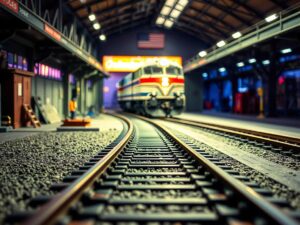How to Add Realistic Roads and Highways to HO Scale Layouts
How to Add Realistic Roads and Highways to HO Scale Layouts
How to Add Realistic Roads and Highways to Your HO Scale Layouts
Hey fellow railroaders! Today, we’re diving into the exciting world of HO scale roads and highways. While trains might be the stars of our hobby, the environments they traverse bring our layouts to life! Building realistic roads adds another layer of detail and immersion, turning your tabletop from a trackbed to a miniature town or sprawling metropolis.
Whether you’re a beginner just starting out or a seasoned modeller looking to refine their skills, this comprehensive guide will equip you with everything you need to create convincing roadways that will elevate your HO scale model railway to the next level.
The Basics: Choosing Your Road Materials
Before we dive into the building process, let’s talk materials. Thankfully, HO scale road building doesn’t require specialized knowledge or exotic tools â just a bit of creativity and the right materials!
-
Styrene Sheets: A go-to for constructing both roads and pavements. Available in various thicknesses, you can cut and shape styrene to create roadbeds, curbs, and even raised roadways.
-
Wood: Light basswood is excellent for making wider roadways or rural gravel roads. Its porous nature allows for realistic textures.
-
Cardboard: Thinner sheets of cardboard are perfect for initial prototyping or temporary structures. They can also be painted and textured to mimic asphalt.
-
Woodland Scenics’ Roadway Set: A popular pre-made kit that includes everything you need to build realistic roads with texture and detail right out of the box.
Laying Down the Foundation: Designing Your Roads
A well-designed road network is crucial for realism and operational efficiency on your layout. Consider these factors when planning your HO scale roads and highways:
- Scale: Remember, every inch of track represents a distance in the real world. Plan accordingly â a few feet of highway on your layout might translate to several miles!
- Functionality: Will your roadways facilitate vehicle movement within your scene? Design routes that accommodate this functionality if required.
- Flow and Traffic: Aim for natural curves, gentle grades, and appropriate road intersections. Think about how traffic would realistically move through your model world.
- Scale Accuracy: Roads in the real world aren’t perfectly straight lines! Embrace curves, gentle dips, and rises to mimic the authentic appearance of roadways.
Crafting Your Roadways: Step-by-Step
Now, let’s build those roads!
-
Preparation: Measure and mark the layout where you want your roadways. Use templates or freehand drawing to create your desired shape.
-
Roadbed Formation (Styrene/Wood):
-
For styrene: Cut and secure the sheets according to your markings, ensuring a firm bond to your layout. Utilize cutting tools like hobby knives or styrene-specific cutters for precision. Consider layering different widths of styrene for raised highways and multi-lane roads.
-
For wood: Cut strips of basswood to create roadbed shapes. Attach them securely using glue (white craft glue or CA glues are excellent options)
-
-
Road Surfaces:
-
Asphalt: A simple coat of black paint on your styrene or wood base provides a basic asphalt look.
Adding Realism with Texture: Use weathering techniques to enhance the asphalt’s texture. Dry-brush lighter grey shades for tire tracks and add a touch of brown ochre along the edges for faded asphalt lines. Fine-grained sandpaper can also create subtle weathering effects when lightly dragged across the painted surface.
-
Gravel Roads:
For wood roads, sprinkle a fine gravel or sand mixture onto glue. Pack it down gently to ensure an even surface. Consider mixing different shades of brown for a more natural look.
-
-
Adding Detail with Paint and Markings:
- Use acrylic paints to define road lines, curbs, crosswalks, and directional signs. Utilize masking tape to create sharp edges. White tape on your asphalt base makes great centerline marking lines!
-
Elevating the Terrain: For raised highways or overpasses, you can:
-
Layer styrene sheets strategically or use foam board.
-
Blend in transitions with sculpting clay for smoother gradients and a more natural feel.
-
Tips & Tricks From a seasoned Modeller
-
Reference Images:
Don’t underestimate the power of real-world inspiration! Gather photos of roads, highways, intersections, and signs to guide your design and color choices. -
Lighting Effects: Use subtle LED lighting behind road embankments or underneath overpasses to add a realistic depth effect and simulate streetlights at night.
-
Vehicle Placement: Remember, empty roadways look incomplete!
Populate your roads with vehicles of varying sizes and types â cars, trucks, construction equipment â all scaled accurately for HO! -
Experiment with Textures: Have fun exploring different textures! Consider using crumbled plaster, fine gravel, or even sandpaper to create unique surfaces on your roads.
-
Scale Your Expectations: Don’t be discouraged by setbacks â patience and experimentation are key! Remember that model railroading is about enjoying the process of creation and celebrating each milestone along the way.
-
Join a Community!:
Find local clubs or online forums to share ideas, get advice from fellow modellers, and connect with like-minded enthusiasts.
Adding realistic roads and highways to your HO scale layouts can seem daunting at first, but with careful planning, attention to detail, and the right techniques, you can transform your miniature world into a believable and captivating landscape.
Let your creativity flow, enjoy the process, and soon, your layout will be the envy of all who witness its meticulously crafted details!




